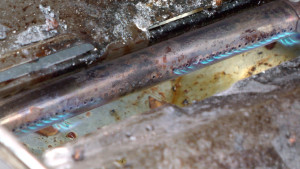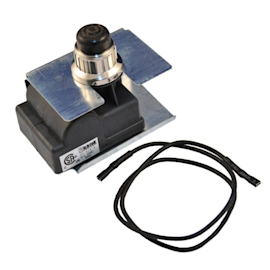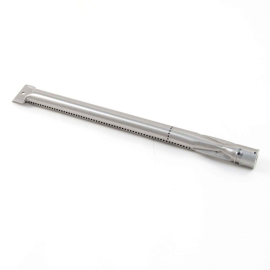- Kenmore refrigerator water filters
- Whirlpool refrigerator water filters
- Samsung refrigerator water filters
- GE refrigerator water filters
- LG refrigerator water filters
- Frigidaire refrigerator water filters
- KitchenAid refrigerator water filters
- Maytag refrigerator water filters
- Kenmore Elite refrigerator water filters
- Estate refrigerator water filters
- GE Profile refrigerator water filters
- Amana refrigerator water filters
- Bosch refrigerator water filters
- Dacor refrigerator water filters
- Electrolux refrigerator water filters
How to fix uneven heating on a gas grill video


Food that cooks unevenly on your gas grill—burnt on one side and raw on the other—is usually because the grill’s flame tamers or burners are clogged, corroded or damaged.
This Sears PartsDirect video shows you what to do if your grill heats unevenly, including how to find and remove clogs, replace damaged parts and then do the Tortilla Test to be sure you fixed the problem.
Check out our DIY Gas Grill Repair Help page for more troubleshooting advice, repair guides and grilling articles.
Supplies you might need
Wire brush
Bamboo skewer or paper clip
Coat hanger
Small bottle brush
Air compressor
Tortillas
Grill tongs
Hi, Wayne here from Sears PartsDirect. Today we're going to talk about how to fix a gas grill when it's not heating evenly. Hot spots or dead areas in the cooking area can really mess up that perfect steak. Nobody wants a steak that’s half rare and half burnt to a crisp. Follow these tips to find out what's wrong and fix the problem so that every bite is cooked to order.
Check for corroded flame tamers
We'll check the flame tamers first. Flame tamers spread out burner heat and protect burners from food drippings. Corrosion can eat through flame tamers, causing hot spots where burner heat shoots up through the corroded holes. Drippings can drop through these flame tamer holes, clogging burner ports and causing cool spots because of an uneven burner flame.
To fix it, shut off the gas tank valve and allow the grill to cool completely. Remove the grates and check the flame tamers for holes. Replace any damaged flame tamers.
If the flame tamers are okay, we'll check the burner tubes. Clogs inside the burner tubes create hot spots as well as cooler areas, so your food won't cook evenly. Spills on the burner tubes cover holes in the tubes, snuffing out sections of the burner flame and creating cool spots. Corrosion also eats away at burner tubes, creating hot and cold spots because of uneven flames.
Pull off the flame tamers and examine the burners. Clean off spills with a wire brush. Clear blocked holes in the burner tubes using a bamboo skewer or paper clip. Replace any burner tubes that have corrosion holes.
How to clean burner tubes on a grill
To clear the insides of the burner tubes, remove them from the grill. Release the carryover tubes from the burners and remove the cotter pins that hold the burners in place. Pull the burner tubes out of the grill and use one of these methods to clean the insides of the tubes.
Heavy wire. Bend a small hook on the end of a stiff wire such as a straightened coat hanger. Run the hook through each burner tube several times to clear out clogs. Dump loosened debris out of the burner tubes.
Small bottle brush. Push a small bottle brush into each burner tube to clear out insects, spiders and debris. Move the brush around vigorously to reach all areas inside the burner tubes. Dump loosened debris out of the burner tubes.
Compressed air. Wearing eye protection, blow debris out of each burner tube using canned air or an air compressor. When using canned air, insert the straw in the canned air nozzle. Insert the extension tube into each burner tube and blow debris out using short bursts of air. When using an air hose, push the nozzle into a burner tube opening and cover the air baffle opening with your fingers so air moves into the burner tube. Loosen debris inside the tube using short bursts of air. Repeat the steps to clean all the burner tubes. Dump loosened debris out of the burner tubes.
Check for even cooking with tortilla test
Reassemble the grill and check for even heating. Start the grill and set all burners to the same setting of medium to high heat. Give the grill a few minutes to preheat. Quickly spread tortillas across the entire cooking surface all at once and check for even cooking. You may still encounter sections of the cooking surface that are heating slightly unevenly, but that's normal.
If you find some tortillas burned, while others are uncooked, that indicates a severely uneven heating pattern. Have a service technician examine the grill to determine the cause and fix it.
I hope that this video helps you out today. You can find links to any parts we talked about in the video description. Check out our other videos on the Sears PartsDirect YouTube channel. Subscribe and we’ll let you know when we post new ones.
Symptoms for gas grills
Choose a symptom to see related gas grill repairs.
Main causes: nearly empty fuel tank, faulty pressure regulator, burner tube clogs, bad burner tube alignment to gas valv…
Main causes: clogged burner tubes, cracked insulators on igniter electrodes, wiring failures, bad ignition module, manif…
Main causes: damaged or dirty flame tamers, corroded firebox, accumulated grease and debris in the grease pan…
Main cause: worn wheel…
Main causes: empty fuel tank, tripped flow-limiting device on the pressure regulator, faulty manifold valves, burner tub…
Repair guides for gas grills
These step-by-step repair guides will help you safely fix what’s broken on your gas grill.

How to replace a gas grill igniter electrode
Replace the igniter electrode on your gas grill if it won’t light the burner.…
Repair difficulty
Time required
15 minutes or less

How to replace a gas grill ignition module
Follow these steps to replace the ignition module if it doesn't produce a spark. …
Repair difficulty
Time required
15 minutes or less

How to replace a gas grill burner
Replace a damaged burner on your gas grill in less than 15 minutes and with just pliers and a screwdriver for tools.…
Repair difficulty
Time required
15 minutes or less
Articles and videos for gas grills
Use the advice and tips in these articles and videos to get the most out of your gas grill.

Learn about all the convenient features on our Sears PartsDirect website that make your parts purchases easier.…

Get answers to frequently asked questions about Sears and Sears PartsDirect.…

Once you've grilled a turkey, you may never go back to the oven roasting. Here's how to grill a brined turkey that's moi…